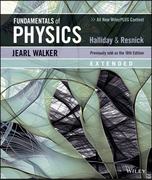?In Fig. 35-4, assume that two waves of light in air, of wavelength 400 nm, are
Chapter 35, Problem 3(choose chapter or problem)
In Fig. 35-4, assume that two waves of light in air, of wavelength 400 nm, are initially in phase. One travels through a glass layer of index of refraction \(n_{1}=1.60\) and thickness L. The other travels through an equally thick plastic layer of index of refraction \(n_{2}=1.50\). (a) What is the smallest value L should have if the waves are to end up with a phase difference of 5.65 rad? (b) If the waves arrive at some common point with the same amplitude, is their interference fully constructive, fully destructive, intermediate but closer to fully constructive, or intermediate but closer to fully destructive?
Text Transcription:
n_1 =1.60
n_2 =1.50
Unfortunately, we don't have that question answered yet. But you can get it answered in just 5 hours by Logging in or Becoming a subscriber.
Becoming a subscriber
Or look for another answer
